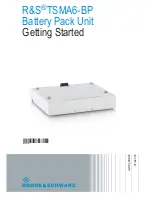
ZGR SWIT NG
Operation manual
www.zigor.com
17
Should the
ZGR SWIT NG and the batteries go to the same box, you must connect ground to the screw provided
in the cabinet. Another cable must be connected from this point to the ground terminal of the
ZGR SWIT NG.
Battery Series
4.3.4
Ensure that the batteries are not cracked, that there are no leaks or dents and that their terminals are not rusted.
Check the characteristics label to ensure that the characteristics of the batteries are the ones ordered
(voltage/capacity/number of elements).
In accordance with the type of battery, you must receive the corresponding accessories (connections, etc.).
Important! Pay attention to the polarity of the connection. Reversing the + and – poles could cause serious
damage to the equipment connected.
The cross section of the cable must be appropriate for the maximum load current.
If lead batteries are supplied, remember to recharge periodically at least every six months if stored.
The final battery connection test consists of measuring the offset voltage, to check whether during assembly the
polarity of any of the elements has been inverted accidentally.
Alarms
4.3.5
Fig. 4-2 Dry contacts
Each of the relays to which an alarm event has been assigned has a three contact terminals (namely, Common
Contact “C”, Normally Open Contact “NA”, Normally Closed Contact “NC”).
By default, each contact can switch a maximum of 5A / 250V in AC and 4A / 30V in DC.
NA
NA
1
2
NC
C
3
4
NC
C
As can be seen in the drawing on the right, the
ZGR SWIT NG has four potential free contacts
(relays) that allow remote monitoring of the
statuses detailed below:
•
R1: rectifier defect (charger failure or
overtemperature).
•
R2: mains outside margins.
•
R3: output defect (maximum output
voltage or /-).
•
R4: next end of discharge.












































